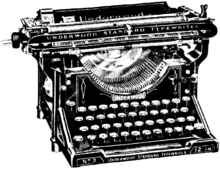Underwood (typewriter)

The Underwood - typewriter goes on a construction of the German-American Franz Xaver Wagner back (1837-1907).
history
The entrepreneur John T. Underwood (1857–1937) acquired the patent for the Wagner gear from Franz Xaver Wagner in 1896 . With previous models from other manufacturers, you had to type “blindly”. Wagner's invention made it possible for the first time to see what was written on the machine immediately and to be able to correct errors. This completely new construction principle gave Underwood a unique success. Among the patents acquired by the Wagners was the patent number 633672, which Underwood used as the basis for his machines.
The first models “Underwood No. 1 " and " Underwood No. 2 ” , manufactured between 1896 and 1900, still had the words “ Wagner Typewriter Co. ” on the back . Around 12,000 of these machines were produced and, if they are in good condition, are now valuable and sought-after collector's items.
The “Underwood No. 3 " , " Underwood No. 4 " and " Underwood No. 5 “ were manufactured from late 1900 to late 1931 or early 1932. The "Underwood No. 3 ” is a machine with a wide carriage , the “ Underwood No. 4 ” writes 76 characters per line and the “ Underwood No. 5 “ writes 84 characters per line.

Underwood had in particular with the model “Underwood No. 5 ” from 1900 a great success in the USA. With its design, this machine set the standard for all subsequent machines from other manufacturers worldwide. She was the quintessential Underwoods. The designation “No. 5 ”or“ Five ”was even given to later machines, as this model was the cornerstone for the success of the Underwood company. The Underwood Typewriter Co. merged in December 1927 with the Elliott Fischer Co. for Underwood Elliott Fischer Co . In the early 1960s, Olivetti bought Underwood and the Underwood brand slowly disappeared from the typewriter market.
The Underwood and its derivatives meant the end for a number of competitors. After 1900 the biodiversity never reached the state before 1890.
The Underwood was the first typewriter to have the Anglo-Saxon ampersand @ in the keyboard, from where it found its way into computers and the Internet.
A state-of-the-art Underwood typewriter designed to represent the world of the future was unveiled at the 1939 New York World's Fair .
Olivetti became the largest shareholder in Underwood in 1959. In 1960, Underwood had been struggling with declining sales for four years, Olivetti had to massively restructure. In October 1963, Underwood was completely taken over by Olivetti to make the Olivetti Group known in the US as "Olivetti-Underwood" with headquarters in New York City. The name Underwood last appeared on a typewriter produced by Olivetti in Spain in the mid-1980s.
Individual evidence
- ^ Patent 633672
- ^ Business & Finance: Underwood-Elliott-Fisher. Time , December 5, 1927; accessed October 23, 2010 .
- ↑ Dieter E. Zimmer : The library of the future. Hoffmann and Campe, 2000, pp. 133-142.
- ↑ Underwood Park. New York City Department of Parks & Recreation, October 23, 2010, accessed October 23, 2010 .
- ^ Corporations: Olivetti Moves In. Time, April 25, 1960, accessed October 23, 2010 .



